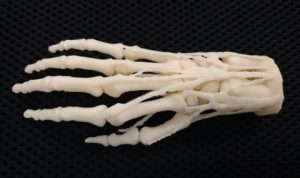Stratasys Unveils Project with US Department of Veterans Affairs
March 17, 2017
Stratasys Ltd. unveiled it is teaming with the US Department of Veteran Affairs to launch one of the first collaborative 3D printing hospital networks in the nation. A significant industry milestone, this effort is the cornerstone of Stratasys’ Corporate Social Responsibility (CSR) program.
 3D printed hand model for teaching, diagnosis, procedural planning. Digital file is a VA resource, hospitals can request models 3D printed on network printers for shipment. (Photo: Business Wire)
3D printed hand model for teaching, diagnosis, procedural planning. Digital file is a VA resource, hospitals can request models 3D printed on network printers for shipment. (Photo: Business Wire)The agreement with the Department of Veterans Affairs Center for Innovation (VACI) is specifically designed to have a positive impact on patient care and doctor preparedness. As the largest integrated healthcare system nationally, the Veterans Health System is leveraging both 3D printers and materials to foster a high level of collaboration and knowledge-sharing throughout hospitals.
“3D printing is expected to have a direct and often immediate impact on societal well-being–with innovation having the power to dramatically shape lives and communities for the better,” says Arita Mattsoff, head of corporate social responsibility, Stratasys. “With three decades of experience and a lifetime of 3D printing innovation, Stratasys is in a unique position to lead meaningful change across many important social causes.”
Stratasys’ CSR effort is aimed at ingraining the power of 3D printing across young minds, bringing transformative medical and educational programs to underprivileged communities, and creating life-changing impacts for the people who need it most.
Stratasys is equipping five Veterans Affairs (VA) hospitals in the U.S. with 3D printers, materials and training to encourage development of custom orthotics, prostheses, and anatomical models for personalized healthcare. The equipment is fully integrated across hospitals, generating a network for building skills and knowledge-sharing across sites–resulting in improved patient outcomes, enhanced surgical collaboration and streamlined costs.
“This 3D printing network is a significant step forward in how we approach patient treatments. The technology not only enables 3D models of a patient’s unique anatomy for diagnosis and treatment, but can also be used to engineer personalized health solutions for Veterans–including prostheses and assistive technologies,” says radiologist Beth Ripley, MD, Ph.D., leader of the VA initiative.
During the initial deployment stage, Stratasys 3D Printers are being installed at VA hospitals in Puget Sound, San Antonio, Albuquerque, Orlando and Boston. Stratasys is also providing 3D printing materials and training alongside support.
“Our work with the VA exemplifies the tremendous difference additive manufacturing is making around the healthcare industry. These solutions now make it possible to not only improve patient care, but set new standards for highly personalized solutions. 3D printing today is advancing healthcare in ways that would have been nearly impossible even a decade ago,” says R. Scott Rader, PhD, GM of Healthcare Solutions at Stratasys.
For more information, visit Stratasys Ltd.
Subscribe to our FREE magazine, FREE email newsletters or both!






